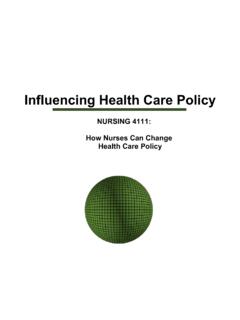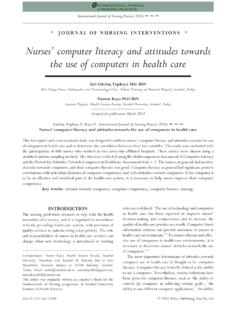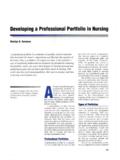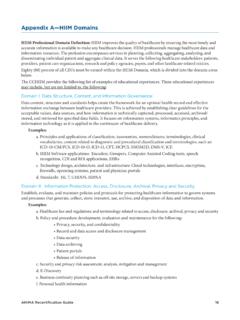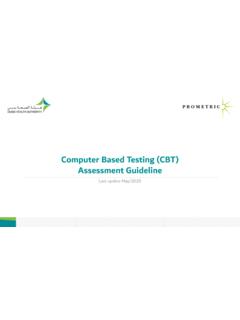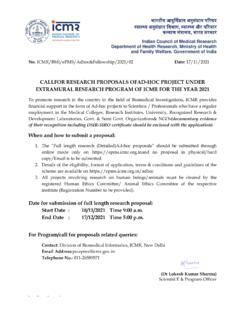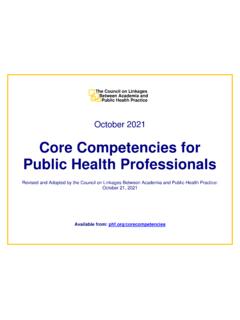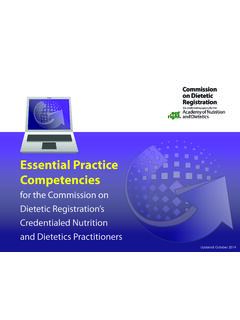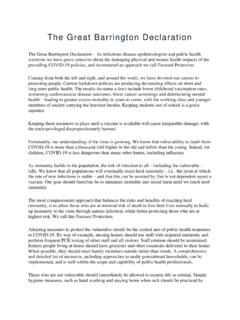Transcription of What is Nursing Informatics and Why is it so Important?
1 50 DRIVEWAY, OTTAWA ON K2P 1E2 TEL: (613) 237-2133 1-800-361-8404 FAX: (613) 237-3520 WEB SITE: E-MAIL: to as Nursing , however, there is a need forall nurses to integrate Nursing informat-ics competencies into their practices. While there is no standard definition forthe concept of Nursing Informatics , thefollowing definition was proposed in the1999 National Nursing InformaticsProject (NNIP) discussion paper:1 Nursing Informatics (NI) is the application ofcomputer science and information science tonursing. NI promotes the generation, manage-ment and processing of relevant data in orderto use information and develop knowledge thatsupports Nursing in all practice of Nursing Informatics areillustrated in figure blocks of nursingcommunicationsThe foundation of Nursing Informatics isbased on the concepts of data, informa-tion andknowledge. Because informationand knowledge are essential for nurseswhen interpreting data and makingdecisions, it is important to know thedifference between these is key to effective decision-making and integral to quality Nursing practice.
2 Much ofwhat nurses do involves information from assessing the health care needs ofpatients, to developing care plans, tocommunicating patient information toother health professionals, to analyzingstaffing and budget reports in fact,nurses work in an in information technology( , computers and software) over thelast 25 years have created significantopportunities for nurses to be aware ofcurrent information when making deci-sions. We have faster computers toprocess data, more sophisticated soft-ware to assist in the transformation ofdata into useful information, and power-ful communication technologies such asthe internet to enable the secure trans-mission of information among healthservice organizations and professionals. Advances in information technologyhave accelerated efforts to implementinformation systems such as theelectronic health record. The electronichealth record(EHR) is a collection of allof an individual s interactions withthe health care system that will beavailable electronically(subject toprivacy, confidentiality and securityguidelines and legislation) to healthcare professionals anywhere in thecountry.
3 EHRs have the potential toenhance nurses decision-makingregarding the delivery of care by sup-plying access to health informationabout clients, allowing data-entry,and offering electronic access to sci-entific knowledge. In Canada, muchwork remains to be done to make theEHR a reality. Advances in information technologyhave created new roles for nurses, andemphasized the need for all nurses tobecome more knowledgeable abouthealth information concepts and thetechnology that is designed to manageand process information. Many nursesrecognize Informatics , derived from theFrench term informatique, as an area ofnursing specialization. Nurses withexpertise in Informatics are oftenWhat is NursingInformatics and Whyis it so Important? Number 11 FIGURE APPLICATIONS OF Nursing INFORMATICSC linical Practice Recording of patient assessment datain an electronic health record Recording of workload and interven-tions as a by-product of electroniccharting Administration Analysis of MIS reports generated froma spreadsheet software application Review of outcome indicators using adecision-support software application Recording of workload and interventionsas a by-product of electronic charting Education Distance learning/teaching via theinternet Recording of workload and interven-tions as a by-product of electroniccharting Research Evaluation of nurse-sensitive outcomemeasures using a standard minimumdata set Use of knowledge bases via the internet Recording of workload and interventionsas a by-product of electronic charting September 2001 CANADIAN NURSES ASSOCIATION, 50 DRIVEWAY, OTTAWA ON K2P 1E2 TEL: (613) 237-2133 1-800-361-8404 FAX.
4 (613) 237-3520 E-MAIL: disciplines and across the con-tinuum of health services need to bestructured and defined in a standard orcommon way this means that notonly do we need standards for com-mon concepts but we also need stan-dards that are compatibleacross infor-mation systems used by differenthealth professions, across the continu-um of health service delivery, and with-in and across provinces and all the challenges,there has been significant progressover the last decade in the develop-ment of health information stan-dards. Highlights of relevant workare provided here.(a) Nursing TerminologyAt the international level, theInternational Council of Nurses (ICN)is leading the development of a univer-sal language for defining and describ-ing Nursing practice the InternationalClassification for Nursing Practice(ICNP ).The purpose of ICNP is to provide atool for describing and documentingkey elements that represent clinicalnursing practice.
5 ICNP provides nurs-ing with a common framework thatfacilitates cross-mapping of existingnursing vocabularies and classifica-tions to enable comparison of nursingdata across organizations, health sec-tors, and countries. The alpha versionof ICNP was released in 1996 forreview and feedback. A significantlyrevised beta version was released in1999 and has been translated intomore than 20 languages.(b) health Information: Nursing ComponentsIn Canada, CNA s HI: NC (HealthInformation: Nursing Components)Working Group has continued to buildon the work started in the early 1990sto develop a standardized minimumdata set for Nursing . There is now anational consensus that critical nursingcare data elements include client status, Nursing intervention and client outcome. While nurses have reached a consen-sus on the kinds of data elementsrequired, they now must begin movingthese concepts to implementation byDataare discrete observations that arenot interpreted, organized or struc-tured.
6 Informationis data that has beeninterpreted, organized or structured toprovide meaning to the data. Andknowledge is the synthesis of informa-tion to identify relationships thatprovide further insight to an issue orsubject area. When you think about it,these concepts are the building blocksof all Nursing communications. Nursescollect data when assessing and moni-toring the health of clients and recordtheir observations in the client s chart;they exchange service requests to, andreceive results from, the clinical labora-tory and radiology departments; theyreceive and review admission data anddischarge summaries; they review infor-mation on the results of clinical trials;they communicate client informationbetween service providers; they sum-marize, calculate and interpret work-load indices for their Nursing unit formonitoring and management purposes;and they consult evidence-based clini-cal guidelines and protocols to guidetheir practice. As knowledge workers,nurses use sources such as these toinfluence examples of data, informationand knowledge relevant to Nursing areprovided three concepts can be stored incomputers and software programs canbe developed to assist in the interpre-tation of the data and the develop-ment of new Nursing knowledge.
7 Whilethe concepts of data, information andknowledge are different, the conceptsas a whole are typically referred togenerically as information. Common language forcommon conceptsThe need for health information stan-dards has never been greater. TheInternational Organization forStandardization (ISO)2defines stan-dards as: documented agreements containingtechnical specifications or other precise criteriato be used consistently as rules, guidelines, ordefinitions of characteristics to ensure thatmaterials, products, processes, and services arefit for their purpose. Today, there are manydifferent types of health informationstandards including technical stan-dards for computer hardware and soft-ware, data standards to enable thedevelopment of quality and compara-ble information, and informationexchange standards or protocols tofacilitate the sharing of information. The development and implementa-tion of computer health information sys-tems orautomated health information sys-temsrequires some form of structuredvocabulary or terminology with com-mon definitions for common terms toenable the effective management andprocessing of data.
8 This may seemsimple but is quite a challenge whenyou consider the complexity of issuesnurses have to deal with. In addition,nurses and other health professionalsoften use different terms and mea-surement instruments to describe thesame thing. For example, functionalstatus, decubitus ulcers, patient fallsand patient self-care are oftendefined and measured differently. To complicate matters further, theadvent of multidisciplinary health pro-grams, regionalization and integratedhealth systems has increased the needfor integrated health information sys-tems that cut across traditional bound-aries. Concepts that are commonData Age Number of home care visits Blood pressure Disease Weight Number of workload units of serviceInformation Prevalence of patient falls by Nursing unit,by month this year compared to last year Prevalence of stage 1-4 decubitusulcers, by quarter % distribution of workload units of ser-vice and intervention by activity catego-ry,by Nursing unit, by monthKnowledge Effectiveness of hip pads in preventinghip fractures Decubitus ulcers treatment protocols Relationship between different nurse-staffmix configurations, Nursing interventionsand client outcomes Care maps for specific health conditions2 CANADIAN NURSES ASSOCIATION, 50 DRIVEWAY, OTTAWA ON K2P 1E2 TEL: (613) 237-2133 1-800-361-8404 FAX: (613) 237-3520 E-MAIL.
9 Confidentiality andsecurity of health informationNurses have identified the protection ofpersonal health information as a criticalissue in the context of rapidly evolvinghealth information as no surprise since nurses,more than any other health profession,use, collect and record health informa-tion extensively in the delivery of and organizations responsi-ble for the development of systemsdesigned to collect, process, store, andshare health information have a respon-sibility to ensure that these systems aresecure in order to maintain the integrityand confidentiality of personal informa-tion. Without this respect for protectingthe privacy of an individual s healthinformation, the public would lose con-fidence in the critical role that healthinformation plays in our health caresystem. At the same time, appropriateaccess to health information and datamay have important benefits forindividual Canadians and for thehealth system as a rapid advances in informationtechnology, nurses need basic knowl-edge of concepts relating to privacy,confidentialityand securityof health infor-mation, especially if they are involvedin the development of health informa-tion systems.
10 While related, theseconcepts are very different. Privacyin relation to health informationis the right of an individual to deter-mine, when, how and to what extentthey will share information about them-selves with others. Confidentialityon theother hand, refers to the obligations ofone person to protect the personalinformation of another person. The pro-tection of the confidentiality of personalhealth information has always been afundamental principle of our healthcare system. The Code of ethics for RegisteredNurses(CNA, 1997) states that nurses safe-guard the trust of clients that informationlearned in the context of a professional relation-ship is shared outside the health care team onlywith the client s permission or as legallyrequired. Finally, securityrefers to the pro-cedures and technologies that are usedto restrict access to, and maintain theintegrity of health information. ensuring that they are included withininformation systems.
